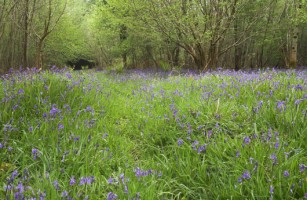- Home
- St. Francis of Assisi
- Sister Mother Earth
- Guide for Nature Lovers
- Ecology Matters!
- Eco-Prayers
- Links & Resources
- Contact Us
Trees grow into Woodlands and Forests

Then shall all the trees of the forest sing for joy
before the Lord; for he is coming,
for he is coming to judge the earth.
- Psalm 96, 12b - 13a
Even trees sing! Of course, this is no surprise for those of us who love trees, because we hear them singing in the various colours of their spring, summer and autumn leaves and even in their winter bareness. We listen to their duet with the breeze passing through their foliage, or marvel at their age or the ruggedness of their trunks and barks ... Trees and woodlands sing in so many varied ways, and their singing praises their Creator and soothes us.
Many Benefits of Trees
As well as the endless enjoyment that people derive from walking through woodland and forests, many other benefits accrue from trees. Some of the benefits are derived from a single tree whilst others come from the value of several or numerous trees functioning together such as a cluster, woodland or forest. As will become clear to you as you read down the page, trees help to sustain the long-term health of the community. Unfortunately, forests and woodlands locally and globally are under increasing threat due to human demand for land for development and agriculture and for timber.
Aesthetic Value of Trees
Trees add to the beauty and peace of our surroundings. They look good and change with the seasons thus softening the hard urban landscape. The irregular shapes of trees and their canopies contrast the squareness and regularity of many of our buildings and enrich our urban and farm landscapes. In addition, trees provide a natural-looking screen and privacy around homes, schools, and hospitals.
Trees Save Energy Costs
Trees reduce temperatures by shading surfaces from the sun. Trees can help us save energy and its costs as trees can shade our homes from summer heat while bare deciduous trees allow for sun exposure during the winter. Trees can be planted to shelter dwellings and pasture or agricultural land from cold winds and reduce the chill factor in an area.
Trees Reduce Carbon Dioxide
Trees are an invaluable resource due to their immense capacity for storing carbon. Trees can help us reduce global warming by absorbing greenhouse gases and storing carbon dioxide that would otherwise be in the atmosphere where there is already too much. Trees also help moderate the local climate as they reduce temperature extremes and generate breezes.
Trees Soak Up Storm Water
Whilst urban and infrastructural development such as housing estates, roads, and paving increase hard, non-evaporative surfaces which may lead to water pollution, erosion and flooding, trees and woodland absorb and store water through normal tree functioning. In soaking up water, trees can help reduce flooding and soil erosion, and help to purify water.
Trees improve Air Quality
Trees improve air quality at local level by absorbing carbon and producing oxygen. They filter airborne dust and pollutants helping to clean the air. However, trees themselves are poisoned by pollution.
Native Trees as Wildlife Habitats
Trees especially those that are native provide the best habitat for wildlife. Many native bird species nest in trees, and butterflies are most numerous and diverse where there are a variety of native trees and bushes together with wild plants. Likewise, native trees support a rich biodiversity of flora and fungi. Trees are living centres for a wide range of species including mammals, insects, birds, wild plants, lichens and fungi. Hedges are hugely valuable 'wildlife corridors' for all the above.
Trees as Sound Buffers
Since trees absorb and reflect sound energy, they can be used to buffer sound, reducing noise pollution. As well as acting as a sound barrier, trees mask man-made noise by the much more pleasant "white noise" of their leaves. The use of trees as sound buffers is especially effective along busy roads and motorways so that people living in these areas, livestock grazing on adjacent farmland and wildlife do not have to endure the relentless sound of passing cars, buses and trucks all day long.
Trees are Good for People
Trees contribute positively to our quality of life. Studies have shown that forested areas like parks can reduce blood pressure and benefit the overall emotional and psychological health of individuals. It is no accident that monasteries and places of retreat are usually planted with trees, bushes and flowers!
.jpg)
Woodland & Forests for Recreation
Trees help create recreational areas that can be enjoyed by walkers, runners, cyclists, and others. Urban trees make walking places safer as they safeguard pedestrians from traffic.
Tree & Forest Websites
Ireland is the least wooded country in Europe - Learn about planting trees and protecting woodlands in Ireland at Crann
Check out the website of Ireland's Native Woodland Trust
Check out the website of Britain's Woodland Trust
Check out Ireland's Close-to-nature permanent forest management
Check out Woodlands as habitats for plants here
Knockanacree Community Woodlands, Cloghjordan, Co. Tipperary
- Pope Francis on Care of Creation 2023
- Biodiversity
- Ireland's Environment in 2016 - An Assessment
- Green Infrastructure
- Endangered Species
- Climate Change
- NATURA 2000 Sites
- Trees & Forests
- Wild Plants
- Seed Saving
- Bee Focus
- Bird Life
- Hedgerows
- Bogs & Peatlands
- Fish & Sea Life
- Mammals
- >>>>>>>>>>>>>>>>
- Stop Climate Change!
- Transition Towns
- Conserving Land
- Pilgrim Paths
- Greenways
- Eco-Congregation